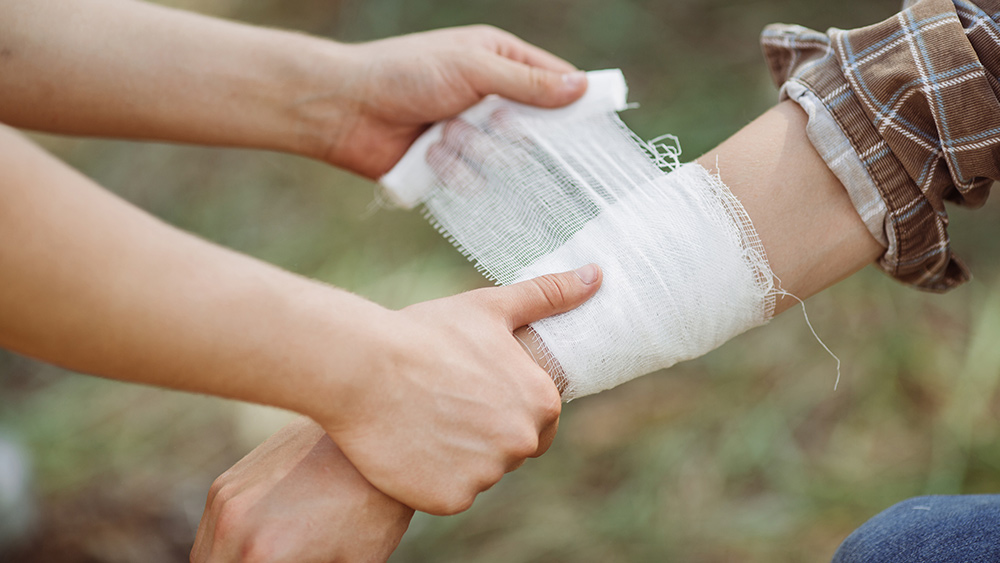Practice these 15 bug-out scenarios so you can survive when SHTF
08/04/2022 / By Zoey Sky

As a prepper, you need to teach your family why you need to practice drills for common bug-out scenarios. This ensures that when SHTF, everyone will know what to do and where to go so you can evacuate quickly and head to a safer location. (h/t to TheSurvivalistBlog.net)
You can’t really fully prepare for everything, but there are certain steps that can increase your chances of survival during bug-out scenarios.
Detailed below are 15 different scenarios that you should practice for before SHTF.
Blackout
A blackout or power outage is a sudden loss of power that can last for hours, days, weeks or even months. A blackout can be caused by severe weather, accidents or malicious attacks.
Before SHTF, make sure you have enough spare batteries, power banks or solar chargers for all your devices.
It can be difficult to evacuate from an area during a blackout since roads will be jammed with traffic and you might be unable to access public transportation. When it’s time to evacuate during a blackout, walk if possible and avoid areas where crowds may form or violence may break out.
Blizzard
Blizzards are common in the northern states, but they can occur anywhere with cold weather and significant snowfall.
A blizzard is a severe winter storm that is often accompanied by strong winds, low temperatures and heavy snowfall. If you find yourself in the path of a blizzard, take shelter immediately.
It’s easier to ride out the storm if you are at home. Bring all pets inside and close off all rooms that are not needed to conserve heat.
If you have to go outside, dress in layers and cover your head and face. Don’t walk through deep snow because you will quickly become exhausted. Exposure to snow during a blizzard may also cause frostbite or hypothermia.
If you decide to bug out, get away before road conditions get too bad since most rescuers won’t be able to reach you.
Earthquake
An earthquake is a shaking or vibration of the Earth’s surface due to the release of energy in its crust. If you are at home during an earthquake, stay inside and move to an interior room on the lowest floor.
Stay away from windows and doors because they may shatter. If you are in bed, don’t try to get out. Instead, cover your head with a pillow until the shaking stops.
If you are outside when an earthquake occurs, stay away from buildings and power lines. Once you’re in a safe area, stay there until the shaking stops.
Economic collapse
An economic collapse occurs when a country’s currency rapidly decreases in value.
This scenario may be caused by many factors like war, natural disasters or political instability. An economic collapse may cause inflation, food shortages and social unrest.
If you live in a country that is experiencing an economic collapse, you may need to bug out.
Before SHTF, plan what you’re going to do and where you’re going to go. Get all the supplies you need to last for several days or weeks.
To prepare for the collapse of currency, invest in hard valuable assets like gold and silver along with basic staples and necessities that your family requires.
Flood
Flooding can occur due to various reasons like heavy rains, melting snow, or dam failure. If you live in an area that is prone to flooding, you need to have a plan in place.
Figure out how you will evacuate if a flood occurs and where you will go. You also need to practice evacuating via several different routes so you can detour if one or more of your usual routes are impassible due to heavy rains.
Flooding involves several hazards like drowning, electrocution from downed power lines and energized equipment, injuries from floating debris and water-borne diseases.
Seek higher ground if your home is destroyed or damaged severely after a flood.
Hurricane
A hurricane is a large and powerful storm that can cause extensive damage to coastal areas. If you live in an area that is prone to hurricanes, you may need to bug out since you may have advance notice of their approach.
A hurricane can cause flooding, loss of power and severe damage to homes. It can also cause injuries or fatalities from flying debris or drowning due to storm surges and rainfall.
If you are facing a hurricane, you may need to shelter in place if roads are impassable or evacuate if your home is no longer safe to stay in.
If you are unable to leave and your home is not directly threatened by storm surge or is in a flood plain, gather the family in an interior room on the lowest floor of your home. Stay there until the storm has passed and bring enough food, water and other supplies that you may need.
Industrial accident
An industrial accident is an unplanned event that may occur in a factory or other workplaces. It can be caused by human error, faulty equipment or inadequate safety protocols.
Industrial accidents can result in fire, explosion, toxic release or structural failure. If you are caught in an industrial accident, don’t try to return to the building to get your belongings.
Instead, leave the area immediately and contact emergency services from afar.
Invasion
An invasion refers to when hostile forces enter your country or community with the intention of causing harm. An invasion may occur due to political religious, or other reasons.
This can happen immediately so you need to prepare. If possible, drive to your bug-out location and use alternate routes.
When fleeing a warzone, bring plenty of essential supplies like food, water, first-aid supplies, clothing and shelter. You can also bring a firearm and ammo so you can protect yourself and your family.
Landslide
A landslide is a natural disaster that can occur when the ground on a slope, cliff face or other vertical expanse becomes unstable and starts to collapse. It may be caused by heavy rains, earthquakes or volcanoes.
Landslides can cause extensive damage to property and infrastructure, along with loss of life. When caught in a landslide, stay calm and avoid being swept away by the movement of the soil.
If you are buried alive, form a small space around your mouth so you can breathe. Don’t move too much because this will make it harder for rescuers to find you.
Once the landslide has stopped, assess your situation and see if you can get out or if you need help.
If you live in an area prone to landslides, learn the warning signs and have a plan in place on what to do if you are caught in a landslide. Prepare an emergency kit and know the best route to safety.
Nuclear strike
A nuclear strike can cause extensive damage to an area and kill many people. If you are near the site of an explosion, you will be exposed to intense heat and radiation.
If you are out in the open when a nuclear device detonates, lie flat on the ground and cover your head with your hands. Do not look at the flash or fireball to avoid permanent blindness.
Take shelter immediately to avoid any fallout or radioactive material that is emitted into the air after a nuclear explosion. Fallout can fall for miles from the explosion site and contaminate anything it touches like food water and land.
If you live in an area that is considered to be a high risk for a nuclear strike, finalize a plan for evacuating. Prepare a bug-out bag with all the supplies you will need for an evacuation.
Riots
Riots can occur for various reasons, like political unrest or economic hardship. They can also turn violent and destructive.
If you are caught in the midst of a riot, try to get away quickly. Do not try to confront the rioters because you may be injured or killed.
Instead, try to blend in with the crowd and escape the disturbance. Be prepared to run.
If riots take place near a home or business, you may need to leave the area. If you can safely evacuate, do so.
If evacuation isn’t possible because it’s not safe to leave, try to barricade yourself inside and stay calm.
Try to stay informed of what is happening in your area so if there is likely to be unrest you can be better prepared.
Terrorist attack
A terrorist attack is a violent act committed by an individual or group to cause fear and panic. This can be done for political, religious or ideological reasons.
Terrorist attacks can occur anywhere and they often target large groups of people in public places. If you find yourself near an attack, you first need to get to a safe place.
Escape from the targeted area or group and be aware of large groups of people. Terrorists will often group victims into tightly defined kill zones for more casualties.
If you are in the middle of a terrorist attack, try to get to safety. Run away from the attacker if possible and take cover if you cannot.
If escape isn’t an option, try to hide and make yourself as small a target as possible. Do not fight back unless absolutely necessary because this can make the situation worse.
Once you are safe, call emergency services and try to give them as much information as possible about the attacker.
Tornado
A tornado is a spinning column of air that forms during a severe thunderstorm. These storms can be very dangerous and may cause extensive damage to property.
If you are in the path of a tornado, seek shelter in areas without windows. Basements and interior rooms are the best places to take cover.
Do not try to outrun the tornado. If you can’t find shelter, lie down flat in a ditch or low-lying area and protect your head with your arms.
Avoid power lines, trees and other objects that could fall on you. Wait for an all-clear before emerging from cover.
If you live in an area that is prone to tornadoes, locate the nearest shelter and find out how to get there quickly. Prepare an emergency kit so you can grab it and take shelter.
Tsunami
A tsunami is a large wave or series of waves that are caused by an earthquake, volcanic eruption, landslide or events. They can cause extensive damage and loss of life.
If you are at the beach when a tsunami warning is issued, get as far inland and on the highest solid ground. Do not try to outrun the wave.
Instead, focus on getting to safety.
If you are at home when a tsunami warning is issued, stay inside and head to an upper floor. If you don’t have an upper floor, go to a room that is furthest from the rising waters.
Stay away from windows and doors because they may shatter. It can take anywhere from a few minutes to an hour for a tsunami to arrive after the original event so you may only have a short window of time to evacuate.
Wildfire
If you live in an area prone to wildfires, finalize an emergency plan. You need to know how you will evacuate if a fire starts and where you will go.
Practice packing your car so you can quickly grab everything you need and evacuate. (Related: Survival essentials: 10 Emergency supply tips for preppers.)
Choose a safe route out of your neighborhood that avoids any areas that could be affected by the fire. Wildfires can move with surprising speed, so don’t underestimate them.
Before SHTF, prepare a bug-out bag with necessary supplies such as:
- Tools for building a shelter or a sleeping bag
- Food and water
- An extra change of clothing
- Flashlights and extra batteries
- Firestarters
- A basic first aid kit
- A map and compass
- A multipurpose tool
- A weapon for self-defense.
Watch the video below to learn about the top 10 forgotten bug-out bag items.
This video is from the Prepping101 channel on Brighteon.com.
More related stories:
20 Wilderness survival tips that might save your life after SHTF.
What you and your community need to do within the first 90 days of a catastrophic collapse.
4 Tips on preparing your homestead for any emergency.
Sources include:
Submit a correction >>
Tagged Under:
bug out, disaster, emergency preparedness, homesteading, nuclear strike, off grid, preparedness, prepper, prepping, SHTF, survival, terrorist attack, tips, wildfire
This article may contain statements that reflect the opinion of the author
RECENT NEWS & ARTICLES
Homesteading.News is a fact-based public education website published by Homesteading News Features, LLC.
All content copyright © 2018 by Homesteading News Features, LLC.
Contact Us with Tips or Corrections
All trademarks, registered trademarks and servicemarks mentioned on this site are the property of their respective owners.




















